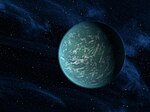Related Research Articles

(29075) 1950 DA is a risk-listed asteroid, classified as a near-Earth object and potentially hazardous asteroid of the Apollo group, approximately 1.3 kilometers in diameter. It once had the highest known probability of impacting Earth. In 2002, it had the highest Palermo rating with a value of 0.17 and a probability of 1 in 306 (0.33%) for a possible collision in 2880. Since that time, the estimated risk has been updated several times. In December 2015, the odds of an Earth impact were revised to 1 in 8,300 (0.012%) with a Palermo rating of −1.42. As of January 2025, it is listed on the Sentry Risk Table with the second highest cumulative Palermo rating of −0.92. 1950 DA is not assigned a Torino scale rating, because the 2880 date is over 100 years in the future. As of 23 January 2025, the odds of an Earth impact are 1 in 2,600 (0.039%).
(292220) 2006 SU49, provisional designation 2006 SU49, is a sub-kilometer asteroid, classified as near-Earth object and potentially hazardous asteroid of the Apollo group that had a small chance of impacting Earth in 2029.
(179806) 2002 TD66 (also written 2002 TD66) is a sub-kilometer asteroid, classified as near-Earth object of the Apollo group. It was discovered on 5 October 2002, by the LINEAR project at Lincoln Laboratory's ETS in Socorro, New Mexico. It was announced on 7 October 2002 and appeared later that day on the JPL current risk page.
(12538) 1998 OH is a stony asteroid, classified as near-Earth object and potentially hazardous asteroid of the Apollo group, approximately 1.8 kilometers in diameter. It was discovered on 19 July 1998, by astronomers of the Near-Earth Asteroid Tracking program at the Haleakala Observatory in Hawaii, United States. This minor planet was numbered by the Minor Planet Center on 23 November 1999. As of 2018, it has not been named. In 2019, the asteroid came within about 73 lunar distances of Earth.
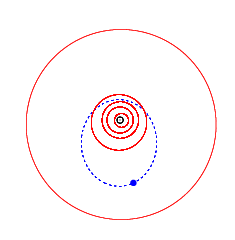
9950 ESA, provisional designation 1990 VB, is an eccentric asteroid and elongated near-Earth object of the Amor group, approximately 1.7 kilometers in diameter. It was discovered on 8 November 1990, by French astronomer Christian Pollas at the Centre de recherches en géodynamique et astrométrie (Cerga) at Caussols in southeastern France. It was named for the European Space Agency (ESA).
(416151) 2002 RQ25 is a carbonaceous asteroid of the Apollo group, classified as near-Earth object and potentially hazardous asteroid, approximately 0.2 kilometers in diameter. It was discovered on 3 September 2002, by the Campo Imperatore Near-Earth Object Survey (CINEOS) at the Italian Campo Imperatore Observatory, located in the Abruzzo region, east of Rome.

367943 Duende (provisional designation 2012 DA14) is a micro-asteroid and a near-Earth object of the Aten and Atira group, approximately 30 meters (98 ft) in diameter. It was discovered by astronomers of the Astronomical Observatory of Mallorca at its robotic La Sagra Observatory in 2012, and named for the duende, a goblin-like creature from Iberian and Filipino mythology and folklore. Duende is likely an uncommon L-type asteroid and significantly elongated. For an asteroid of its size, it has a relatively long rotation period of 9.485 hours.
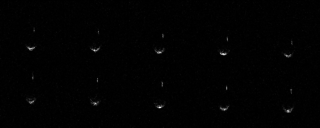
(410777) 2009 FD is a carbonaceous sub-kilometer asteroid and binary system, classified as near-Earth object and potentially hazardous asteroid of the Apollo group, discovered on 24 February 2009 by astronomers of the Spacewatch program at Kitt Peak National Observatory near Tucson, Arizona, in the United States.
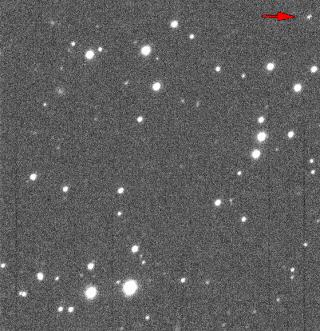
(511002) 2013 MZ5, provisional designation 2013 MZ5, is a sub-kilometer asteroid, classified as a near-Earth object of the Amor group, estimated to measure approximately 300 meters (1,000 feet) in diameter. It was discovered on 18 June 2013, by astronomers with the Pan-STARRS survey at Haleakala Observatory on the island of Maui, Hawaii, in the United States. It was the 10,000th near-Earth object ever discovered.
(454101) 2013 BP73, provisional designation 2013 BP73, is a sub-kilometer asteroid, classified as a near-Earth object and potentially hazardous asteroid of the Apollo group, approximately 310 meters (1,020 ft) in diameter.
2008 CK70 (also written 2008 CK70) is an Apollo near-Earth asteroid. In 2013 it had the 7th highest impact threat on the Palermo Technical Impact Hazard Scale. It was discovered on 9 February 2008 by Lincoln Near-Earth Asteroid Research (LINEAR) at an apparent magnitude of 19 using a 1.0-meter (39 in) reflecting telescope. It has an estimated diameter of 31 meters (102 ft) and is not large enough to qualify as a potentially hazardous object. Ten precovery images from January 2008 have been located. It was removed from the Sentry Risk Table on 21 December 2013. It may be possible to recover the asteroid in late September 2017, but it will have an apparent magnitude of about 22.
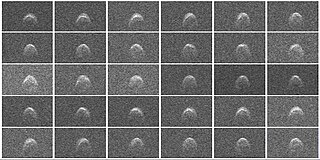
(277475) 2005 WK4, provisional designation 2005 WK4, is a stony, sub-kilometer asteroid, classified as near-Earth object and potentially hazardous asteroid of the Apollo group that passed Earth within 8.2 lunar distances on 8 August 2013. It was discovered on 27 November 2005, by astronomers of the Siding Spring Survey at Siding Spring Observatory, Australia.
(163132) 2002 CU11, provisional designation 2002 CU11, is a bright, sub-kilometer asteroid, classified as near-Earth object and potentially hazardous asteroid of the Apollo group. Based on absolute magnitude, it is the second largest asteroid known to have passed closer than the Moon.
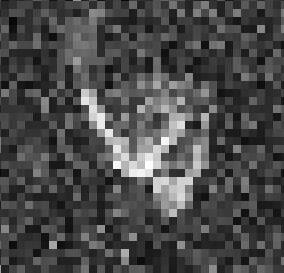
(192642) 1999 RD32, provisional designation: 1999 RD32, is an asteroid and suspected contact binary on an eccentric orbit, classified as a large near-Earth object and potentially hazardous asteroid of the Apollo group, approximately 5 kilometers (3 miles) in diameter. It was discovered on 8 September 1999, at a magnitude of 18, by astronomers of the LINEAR program using its 1-meter telescope at the Lincoln Laboratory's Experimental Test Site near Socorro, New Mexico, United States. The asteroid is likely of carbonaceous composition and has a rotation period of 17.08 hours.
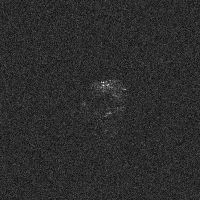
(436724) 2011 UW158, provisionally known as 2011 UW158, is a stony, walnut-shaped asteroid and fast rotator, classified as near-Earth object and potentially hazardous asteroid of the Apollo group, approximately 300 meters in diameter. It was discovered on 25 October 2011, by Pan-STARRS at Haleakala Observatory on the island of Maui, Hawaii, in the United States.
(159857) 2004 LJ1, provisional designation 2004 LJ1, is an asteroid on an eccentric orbit, classified as near-Earth object and potentially hazardous asteroid of the Apollo group, approximately 3 kilometers in diameter. The asteroid was discovered on 10 June 2004, by astronomers of the LINEAR program at Lincoln Laboratory's Experimental Test Site near Socorro, New Mexico, in the United States. It is one of the largest potentially hazardous asteroids known to exist.
(163243) 2002 FB3, provisional designation 2002 FB3, is a stony asteroid on an eccentric orbit, classified as near-Earth object and potentially hazardous asteroid of the Athen group, approximately 1.6 kilometers (1 mile) in diameter. It was discovered on 18 March 2002, by astronomers with the Lincoln Near-Earth Asteroid Research at the Lincoln Laboratory's Experimental Test Site near Socorro, New Mexico, in the United States. The Q-type asteroid has a rotation period of 6.2 hours.
(85182) 1991 AQ is a stony asteroid on a highly eccentric orbit, classified as near-Earth object and potentially hazardous asteroid of the Apollo group, approximately 1.1 kilometers in diameter. It was discovered on 14 January 1991, by American astronomer Eleanor Helin at the Palomar Observatory in California. Based on its brightness variation of 0.69 magnitude, this Q-type asteroid is likely elongated. It belongs to the small group of potentially hazardous asteroids larger than one kilometer.
(385343) 2002 LV, provisional designation 2002 LV, is a stony asteroid on a highly eccentric orbit, classified as near-Earth object and potentially hazardous asteroid of the Apollo group, approximately 1.5 kilometers in diameter. It was discovered on 1 June 2002, by astronomers with the Lincoln Near-Earth Asteroid Research at the Lincoln Laboratory's Experimental Test Site near Socorro, New Mexico, in the United States. The Sr-type asteroid has a rotation period of 6.2 hours and is likely elongated.

2016 DV1 is a near-Earth asteroid estimated to be roughly 29–65 meters (95–210 feet) in diameter. It is a fast rotating asteroid of the Apollo group which was first observed by the Mount Lemmon Survey on 28 February 2016, just days before it passed Earth at 1 lunar distance (LD) on 3 March 2016. The elongated fast rotator has a rotation period of 303 seconds. It was recovered in February 2021 as it was about to pass Earth on 3 March 2021 at a distance of 0.0053 AU (2.1 LD; 790,000 km; 490,000 mi).
References
- 1 2 3 4 5 6 "JPL Small-Body Database Browser: 471240 (2011 BT15)" (2017-03-18 last obs.). Jet Propulsion Laboratory . Retrieved 2 June 2017.
- 1 2 3 4 "471240 (2011 BT15)". Minor Planet Center. Retrieved 24 April 2017.
- 1 2 "MPEC 2011-B43 : 2011 BT15". IAU Minor Planet Center. 27 January 2011. Retrieved 10 January 2013. (K11B15T)
- 1 2 3 4 5 6 7 "LCDB Data for (471240)". Asteroid Lightcurve Database (LCDB). Retrieved 24 April 2017.
- 1 2 3 4 5 "Earth Impact Risk Summary: 2011 BT15". Wayback Machine: NASA/JPL Near-Earth Object Program Office. Archived from the original on 18 February 2013. Retrieved 27 July 2013. (1.4e-05 = 1 in 71,000 chance)
- 1 2 Warner, Brian D. (July 2014). "Near-Earth Asteroid Lightcurve Analysis at CS3-Palmer Divide Station: 2014 January-March". The Minor Planet Bulletin. 41 (3): 157–168. Bibcode:2014MPBu...41..157W. ISSN 1052-8091. PMC 7296834 . PMID 32549046.
- 1 2 "Sentry Risk Table". Wayback Machine: NASA/JPL Near-Earth Object Program Office. 10 January 2013. Archived from the original on 10 January 2013. Retrieved 27 July 2013.
- 1 2 "JPL Close-Approach Data: (2011 BT15)" (last observation: 2013-07-18; arc: 5.9 years). Retrieved 10 January 2013.
- ↑ Dr. Lance A. M. Benner (12 August 2013). "Goldstone Asteroid Schedule". NASA/JPL Asteroid Radar Research. Retrieved 16 August 2013.
- ↑ "Date/Time Removed". NASA/JPL Near-Earth Object Program Office. Archived from the original on 2 June 2002. Retrieved 27 July 2013.
- ↑ Math: 103.58 = 3801
- ↑ "The Palermo Technical Impact Hazard Scale". NASA/JPL Near-Earth Object Program Office. 31 August 2005. Archived from the original on 21 March 2002. Retrieved 14 October 2011.
- ↑ Horizons output. "Horizon Online Ephemeris System" . Retrieved 10 January 2013. (Geocentric Solution)
